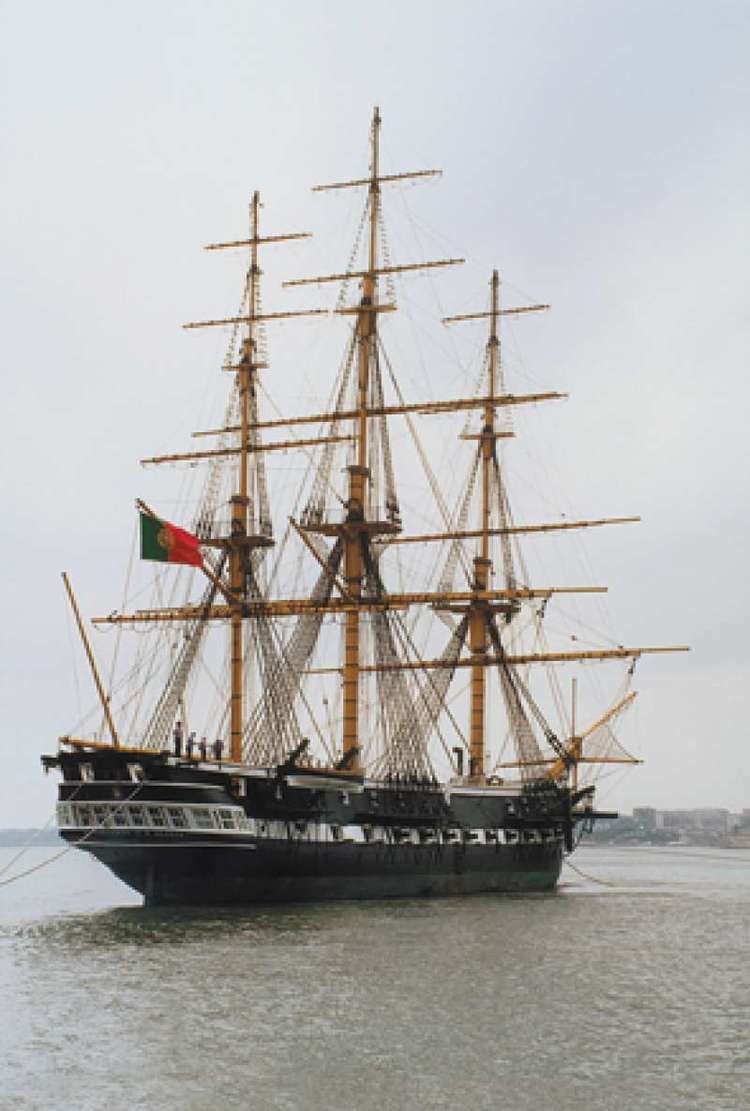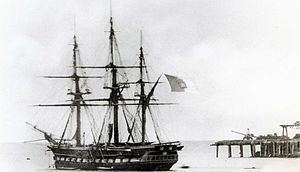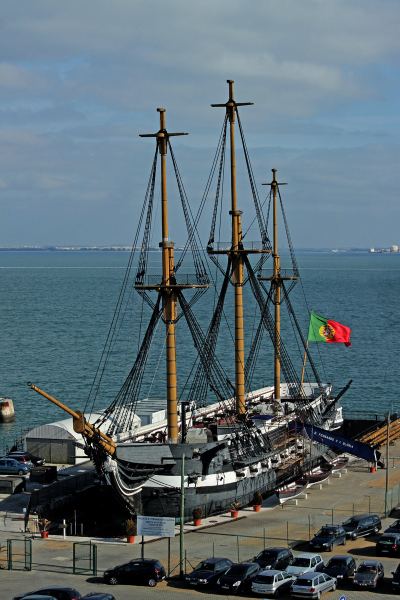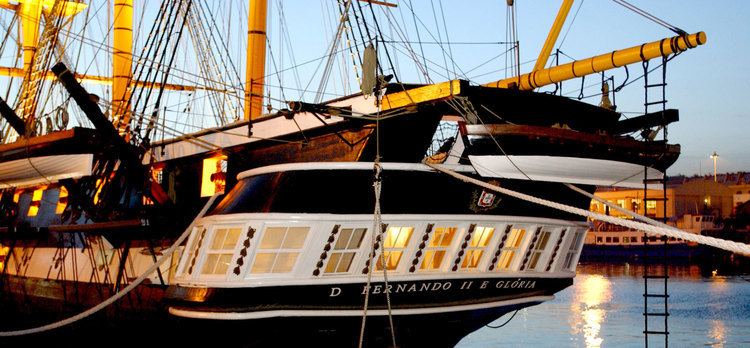Ordered 1821 In service 1845 Length 87 m Draft 6.4 m | Maiden voyage 2 February 1845 Class and type 50-gun Frigate Launched 22 October 1843 Beam 13 m | |
 | ||
Name Dom Fernando II e Glória Status Preserved as a museum ship in Almada, Portugal | ||
Dom Fernando II e Glória is a wooden-hulled, 50 gun frigate of the Portuguese Navy. She was launched in 1843 and made her maiden voyage in 1845. Built at the shipyard of Daman in the Portuguese India, it was Portugal's last sailing warship to be built and also the last ship that undertook the Carreira da Índia (India Run), a regular military line that connected Portugal to its colonies in India since the beginning of the 16th century.
Contents

The ship remained in active service until 1878, when she made her last sea voyage, having travelled more than one hundred thousand miles, the equivalent of five circumnavigations of the world.

After long service it was almost destroyed by a fire in 1963 with the burned wooden-hull remaining beached at the mud-flats of the river Tagus for the next 29 years. Finally in 1990 the Portuguese Navy decided to restore her to her appearance in the 1850s. During the World Exhibition of 1998 the ship remained in Lisbon as a museum ship on the dependency of the Navy Museum, being classified as an Auxiliary Navy Unit (UAM 203). Since 2008, the ship lies on the southern margin of the Tagus river in Cacilhas, Almada.

Construction

In 1821, the Intendant of the Royal Navy of Goa, Cândido José Mourão Garcez Palha, proposed to the Portuguese government the construction of a new frigate in the Portuguese colony of Daman, who possessed to the east a large forest of teak wood in Nagar-Aveli, considered to be an excellent wood for ship building. The authorization for the construction was given in 1824, by the Portuguese king João VI. The civil war period and the political and economical problems in Portugal, delayed the construction for several times throughout the years. She was built in the Shipyards of the Royal Navy Arsenal under the supervision of the naval builder engineer Gil José da Conceição, being involved in its construction both Portuguese and Indian workers. She was finally launched in 1843, and towed to Goa for fitting out as a full-rigged ship.

She was named as a tribute to the king consort of Portugal Ferdinand II, husband of the Portuguese Queen Maria II, and to Our Lady of Glory, a figure of special devotion among the catholic population of Goa.

The frigate was noted for her spacious accommodations, a critical factor on voyages that could take three months or even more without an intermediate port of call.
Service
The maiden voyage took place between 2 February and 4 July 1845 under the command of Captain Torcato José Marques, with a crew of 145 men, connecting Goa to Lisbon. Since then it was used on several types of missions over the years:
In 1865, she replaced the sailing ship Vasco da Gama as the Artillery School of the Portuguese Navy, conducting training missions up until 1878, when it completed her last training mission on sea in a voyage to the Azores islands. In this last voyage she rescued the crew of the American barque Lawrence Boston, which had caught fire off the Azores archipelago. After this, she remained permanently moored in Lisbon as the Naval Artillery School with significant modifications being made on her in 1889, with the replacement of her elegant masts, and the construction of two redoubts on both her sides for the placement of modern cannons, to better serve her role of artillery instruction unit.
In 1938 served as the flagship of the naval forces of Continental Portugal, based in the river Tagus.
Fire and damage
In 1940, after being considered unfit for navy service, it became the headquarters of the Fragata Dom Fernando Welfare Institution (Obra Social da Fragata Dom Fernando) destined to give general education as well as teaching seamanship to underprivileged youth, up until 3 April 1963. On this day, during repair work, a huge fire erupted, partially destroying the ship's hull and structure. After the fire was extinguished, the frigate was towed to an area where the navigation on the river Tagus wouldn't be disturbed, remaining abandoned and half buried in the mud-flats for the next 29 years.
Reconstruction
In October 1990 the Portuguese Navy and the National Commission for the Commemoration of the Portuguese Discoveries initiated efforts in order of restoring the frigate as she was in the 1850s. On 22 January 1992, the wooden hull was removed from the mud-flats and set floating again, placed in a floating dock and transported to the dry dock of the Arsenal of Alfeite first, and in 1993 to the Ria-Marine shipyards in Aveiro, where it remained for the next 5 years being restored, receiving widespread public and private support. On 27 April 1998, the Dom Fernando II e Glória was reinstated in the Portuguese Navy as an Auxiliary Navy Unit (UAM 203).
On 12 August 1998, it was delivered to the Navy Museum after being considered by Decree an Historical Navy Ship on 18 July 1998. During its stay at Expo '98 that marked the 500th anniversary of the discovery of the sea route to India by Vasco da Gama, she was a major attraction being visited by almost 900,000 people.
In September 1998, the World Ship Trust awarded the Dom Fernando II e Glória with the International Maritime Heritage Award, who considers her restoration as one of the most astonishing historic ship preservation achievements of our time.
The International Register of Historic Ships considers the Dom Fernando II e Glória as the fourth oldest armed frigate, and the eight oldest sailing warship in the world.
